-
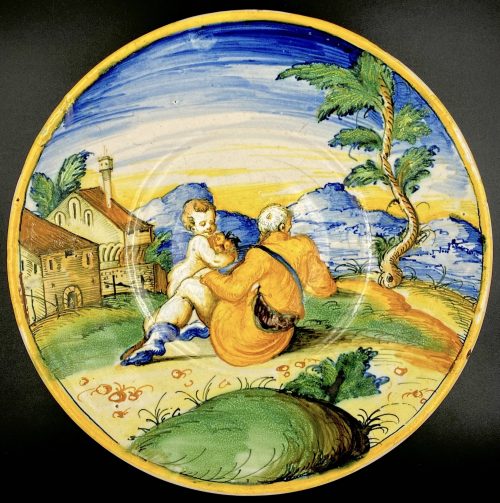
-
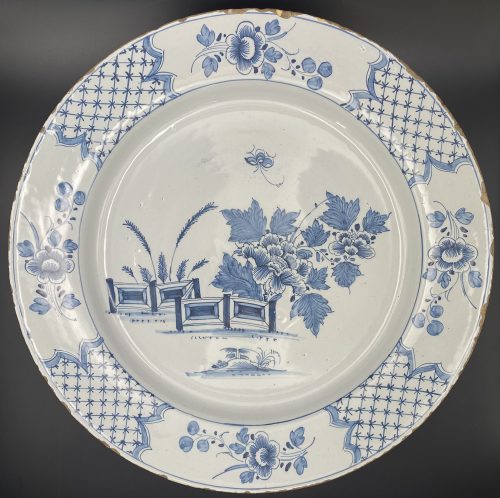 Round plate with a blue and white design of blossoming peony behind a fence with lattice and floral border; flowers to the bottom. Diameter: 33 cm, Haight: 4.5 cm.
Round plate with a blue and white design of blossoming peony behind a fence with lattice and floral border; flowers to the bottom. Diameter: 33 cm, Haight: 4.5 cm. -
 Iron tsuba of the round form (maru gata) with a grey patina pierced with the design of slanting rays of light (Jesuit’s IHS symbol) and a pair of ginger symbols [茗荷] (myōga) at top and bottom, in positive silhouette (ji-sukashi). This design is often called “tokei” [時計] or “clock gear”. Rounded rim, large hitsu-ana, copper fittings (sekigane). Unsigned, unpapered. Owari school. Early Edo period, early 17th century.
Iron tsuba of the round form (maru gata) with a grey patina pierced with the design of slanting rays of light (Jesuit’s IHS symbol) and a pair of ginger symbols [茗荷] (myōga) at top and bottom, in positive silhouette (ji-sukashi). This design is often called “tokei” [時計] or “clock gear”. Rounded rim, large hitsu-ana, copper fittings (sekigane). Unsigned, unpapered. Owari school. Early Edo period, early 17th century.Size: H 71.9 x W 71.1 x Th (centre) 5.5 cm.
For information regarding this type of tsuba see the article 'Kirishitan Ikenie Tsuba by Fred Geyer at Kokusai Tosogu Kai; The 2nd International Convention & Exhibition, October 18-23, 2006, pp. 84-91. 
IHS emblem of the Jesuits

茗荷 Myoga or Japanese ginger
-
 Iron tsuba of slightly elongated round form decorated with design of melon flowers, vines, and leaves in brass flat inlay (hira-zōgan) on both sides. Slightly raised rim (mimi) carved in a way to simulate ring-shaped covering (fukurin). Kozuka hitsu-ana and kogai hitsu-ana both plugged with soft metal (tim or lead). Copper sekigane. Heianjō or Kaga School. Muromachi or Momoyama period, 16th century. Iron, hira-zōgan brass inlay. Round (maru gata) form, diameter 79 mm. Size: 80.3 x 78.4 mm; thickness at seppa-dai: 3.4 mm; at the middle: 3.8 mm; before the rim: 2.4 mm, rim: 2.8 mm. Note on design: though this design resembles family crests with oak and mulberry leaves, I believe it's a melon flower [see Jeanne Allen. Designer's guide to Samurai Patterns. Chronicle Books, San Francisco, 1990, page 114, №130 "Melon Flowers":Note about the distribution of thickness (niku-oki): "this tsuba has toroid features, niku raises from the rim towards the centre but thins once more out when approaching the seppa-dai" [M. Sesko, "Handbook...", p. 48].
Iron tsuba of slightly elongated round form decorated with design of melon flowers, vines, and leaves in brass flat inlay (hira-zōgan) on both sides. Slightly raised rim (mimi) carved in a way to simulate ring-shaped covering (fukurin). Kozuka hitsu-ana and kogai hitsu-ana both plugged with soft metal (tim or lead). Copper sekigane. Heianjō or Kaga School. Muromachi or Momoyama period, 16th century. Iron, hira-zōgan brass inlay. Round (maru gata) form, diameter 79 mm. Size: 80.3 x 78.4 mm; thickness at seppa-dai: 3.4 mm; at the middle: 3.8 mm; before the rim: 2.4 mm, rim: 2.8 mm. Note on design: though this design resembles family crests with oak and mulberry leaves, I believe it's a melon flower [see Jeanne Allen. Designer's guide to Samurai Patterns. Chronicle Books, San Francisco, 1990, page 114, №130 "Melon Flowers":Note about the distribution of thickness (niku-oki): "this tsuba has toroid features, niku raises from the rim towards the centre but thins once more out when approaching the seppa-dai" [M. Sesko, "Handbook...", p. 48].
Jeanne Allen. Designer's guide to Samurai Patterns. Chronicle Books, San Francisco, 1990. Page 114, №130.
-
 Onin Tsuba with two overlapping lozenges, or interlocked diamond shapes. Iron and brass. Sukashi and ten-zogan technique. Muromachi period. Diameter: 81.0 mm; Thickness at seppa-dai: 3.2 mm The symbol of two overlapping lozenges (or, interlocked diamond shapes), presumably a family crest (kamon) may be deciphered as chigai kuginuki (nail extraction tool => 'conquered nine castles' ) or as chigai bishi (overlapping lozenges). Similar symbol can be found at Butterfield & Butterfield. IMPORTANT JAPANESE SWORDS, SWORD FITTINGS AND ARMOR. Auction Monday, November 19th, 1979. Sale # 3063], №94 with the following explanation: " This was the mon (crest) of the Yonekura family of Kaga Prov., at Kanazawa". An interesting insight is provided by Robert E. Haynes at Important Japanese kodogu, gaiso and works of art. San Francisco, April 9-11, 1982. Robert E. Haynes, Ltd., № 36 (see photo): "This would seem to be the Yonekura family mon. They were Seiwa-Genji Daimyō family made noble in 1696 and resided in Kanazawa in Kaga". Would it be possible that this is a late 17th century Ōnin tsuba?
Onin Tsuba with two overlapping lozenges, or interlocked diamond shapes. Iron and brass. Sukashi and ten-zogan technique. Muromachi period. Diameter: 81.0 mm; Thickness at seppa-dai: 3.2 mm The symbol of two overlapping lozenges (or, interlocked diamond shapes), presumably a family crest (kamon) may be deciphered as chigai kuginuki (nail extraction tool => 'conquered nine castles' ) or as chigai bishi (overlapping lozenges). Similar symbol can be found at Butterfield & Butterfield. IMPORTANT JAPANESE SWORDS, SWORD FITTINGS AND ARMOR. Auction Monday, November 19th, 1979. Sale # 3063], №94 with the following explanation: " This was the mon (crest) of the Yonekura family of Kaga Prov., at Kanazawa". An interesting insight is provided by Robert E. Haynes at Important Japanese kodogu, gaiso and works of art. San Francisco, April 9-11, 1982. Robert E. Haynes, Ltd., № 36 (see photo): "This would seem to be the Yonekura family mon. They were Seiwa-Genji Daimyō family made noble in 1696 and resided in Kanazawa in Kaga". Would it be possible that this is a late 17th century Ōnin tsuba?
Robert E. Haynes Catalog of April 9-11, 1982, № 36.
-
 Iron tsuba of half round and half lobed (chrysanthemoid) form decorated with plants and family crests (mon) in cast brass inlay (suemon-zōgan), and scattered brass dots inlay (ten-zōgan); brass wire inlay outlining the rim, seppa-dai, and hitsu-ana (scalloped wire) on both sides. Surface treated with hummer punch marks. The chrysanthemoid half of the plate chiseled with thin shallow grooves, outlining the petals. Copper sekigane. On the face the inlay represents: mandarin orange (tachibana), half karahana, encircled bellflower, and four encircled three-stipe family crest (mitsubiki-mon of Sakuma and Abe clans, and some others). On the reverse the design is similar but two of the mitsubiki-mon symbols replaced with two comb-shaped Genji-mon ideographs. Ōnin school. The end of mid-Muromachi period, beginning of the 16th century. Size: 74.3 x 72.7 x 2.4 mm.
Iron tsuba of half round and half lobed (chrysanthemoid) form decorated with plants and family crests (mon) in cast brass inlay (suemon-zōgan), and scattered brass dots inlay (ten-zōgan); brass wire inlay outlining the rim, seppa-dai, and hitsu-ana (scalloped wire) on both sides. Surface treated with hummer punch marks. The chrysanthemoid half of the plate chiseled with thin shallow grooves, outlining the petals. Copper sekigane. On the face the inlay represents: mandarin orange (tachibana), half karahana, encircled bellflower, and four encircled three-stipe family crest (mitsubiki-mon of Sakuma and Abe clans, and some others). On the reverse the design is similar but two of the mitsubiki-mon symbols replaced with two comb-shaped Genji-mon ideographs. Ōnin school. The end of mid-Muromachi period, beginning of the 16th century. Size: 74.3 x 72.7 x 2.4 mm. -

Iron tsuba of mokko form with rough surface decorated in low relief carving (sukidashi-bori) and openwork (sukashi) with a flying bat, a crescent moon, and a cloud over the moon. Bat's eyes inlaid with gold. Crescent moon and cloud on the reverse. Copper sekigane. Kogai hitsu-ana plugged with shakudō.
Unsigned.
Edo period.Size: Height: 83.7 mm; Width: 80.3 mm; Thickness: 2.9 mm; Weight: 141 g.
-
 Iron tsuba of octafoil form with design of rudder (kaji) and lake in openwork (sukashi) outlined with brass wire. Thin plate also decorated with three concentric circular rows of brass dots (nail heads) in ten-zōgan. Center of the plate outlined with the inlaid circular brass wire. Cut-outs for kozuka and kogai probably added later. Slightly raised rim between the indentations (suki-nokoshi-mimi). The inlaid metal of red-ish hue, so it may be copper, not brass. Sekigane, visible on the NBTHK paper photo, are missing, possibly removed by a previous owner. Muromachi period. Ōnin school. Unsigned. Dimensions: 81.2 mm x 81.8 mm x 2.7 mm. Weight: 79.0 g. Large nakago-ana: 34 mm high and 10 mm wide. NBTHK certificate №455786: Hozon. Note regarding design: it was quite hard to interpret the big oval opening. The first suggestion was 'sea cucubmer', and it was based on a design published by Kazutaro Torigoye [Kodogu and tsuba. International collections not published in my books (Toso Soran), 1978] on page 202: Katchūshi tsuba: Sea cucumber and butterfly. Look and judge yourself:The second suggestion - 'lake' - came from [Iron tsuba. The works of the exhibition "Kurogane no hana", The Japanese Sword Museum, 2014], page 14 №5:
Iron tsuba of octafoil form with design of rudder (kaji) and lake in openwork (sukashi) outlined with brass wire. Thin plate also decorated with three concentric circular rows of brass dots (nail heads) in ten-zōgan. Center of the plate outlined with the inlaid circular brass wire. Cut-outs for kozuka and kogai probably added later. Slightly raised rim between the indentations (suki-nokoshi-mimi). The inlaid metal of red-ish hue, so it may be copper, not brass. Sekigane, visible on the NBTHK paper photo, are missing, possibly removed by a previous owner. Muromachi period. Ōnin school. Unsigned. Dimensions: 81.2 mm x 81.8 mm x 2.7 mm. Weight: 79.0 g. Large nakago-ana: 34 mm high and 10 mm wide. NBTHK certificate №455786: Hozon. Note regarding design: it was quite hard to interpret the big oval opening. The first suggestion was 'sea cucubmer', and it was based on a design published by Kazutaro Torigoye [Kodogu and tsuba. International collections not published in my books (Toso Soran), 1978] on page 202: Katchūshi tsuba: Sea cucumber and butterfly. Look and judge yourself:The second suggestion - 'lake' - came from [Iron tsuba. The works of the exhibition "Kurogane no hana", The Japanese Sword Museum, 2014], page 14 №5:
Torigoye: sea cucumber and butterfly.
Opening on my tsuba looks more like the 'lake'. Also, rudder and lake make more sense than rudder and sea cucumber. At least to me...
Ko-Katchūshi tsuba: Lake and pine.
-
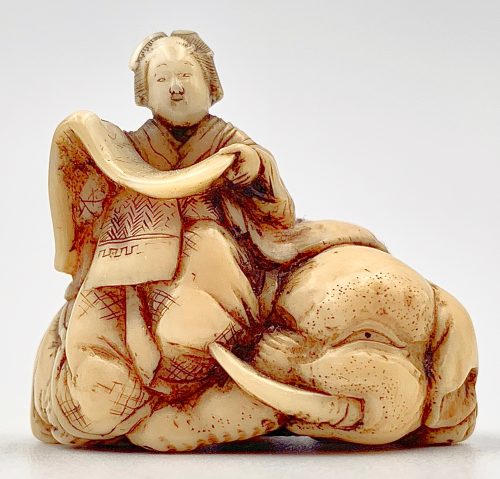 Netsuke of Kimi no Eguchi on a recumbent elephant. Signed: Toun. Circa 1850. 33.7 x 30.8 x 22.7 mm. The Courtesan Eguchi no kimi as Fugen, Bodhisattva of Universal Wisdom (Eguchi no kimi mitate Fugen Bosatsu). The imagery satirizes the Buddhist bodhisattva Fugen, whose iconographic mount is an elephant, by replacing the deity with a beautifully coiffed modern courtesan. Such a visual pun (mitate) was an artistic trope, popular in the Edo period. Provenance: Charles Ephrussi (1849-1905) acquired in the 1870s; a wedding gift in 1898 to his cousin Ritter Viktor von Ephrussi (1860-1945) and Baroness Emilie (Emmy) Schey von Koromla (1879-1938); retrieved post-war by their daughter Elizabeth de Waal (1899-1991); given by her to her brother Ignaz (Iggie) Ephrussi (1906-1994), Tokyo; bequeathed by him to his great-nephew Edmund de Waal (born 1964), London, author of "The Hare with Amber Eyes: a hidden inheritance". London / New York: Chatto & Windus / Farrar, Straus & Giroux. ISBN 978-0099539551. https://en.wikipedia.org/wiki/Charles_Ephrussi. https://en.wikipedia.org/wiki/Ephrussi_family. https://en.wikipedia.org/wiki/Edmund_de_Waal.
Netsuke of Kimi no Eguchi on a recumbent elephant. Signed: Toun. Circa 1850. 33.7 x 30.8 x 22.7 mm. The Courtesan Eguchi no kimi as Fugen, Bodhisattva of Universal Wisdom (Eguchi no kimi mitate Fugen Bosatsu). The imagery satirizes the Buddhist bodhisattva Fugen, whose iconographic mount is an elephant, by replacing the deity with a beautifully coiffed modern courtesan. Such a visual pun (mitate) was an artistic trope, popular in the Edo period. Provenance: Charles Ephrussi (1849-1905) acquired in the 1870s; a wedding gift in 1898 to his cousin Ritter Viktor von Ephrussi (1860-1945) and Baroness Emilie (Emmy) Schey von Koromla (1879-1938); retrieved post-war by their daughter Elizabeth de Waal (1899-1991); given by her to her brother Ignaz (Iggie) Ephrussi (1906-1994), Tokyo; bequeathed by him to his great-nephew Edmund de Waal (born 1964), London, author of "The Hare with Amber Eyes: a hidden inheritance". London / New York: Chatto & Windus / Farrar, Straus & Giroux. ISBN 978-0099539551. https://en.wikipedia.org/wiki/Charles_Ephrussi. https://en.wikipedia.org/wiki/Ephrussi_family. https://en.wikipedia.org/wiki/Edmund_de_Waal. -
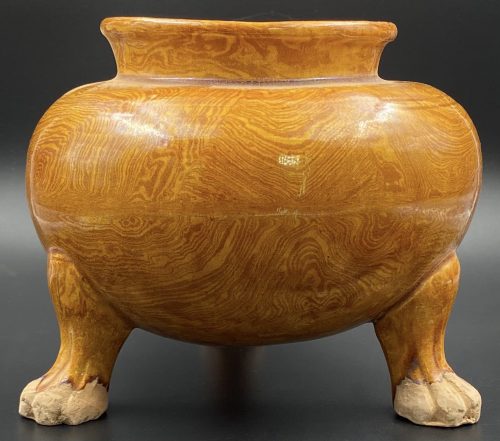 Amber-glazed marbled pottery tripod censer, standing on unglazed beast's paws. The clay itself is not marbled, only the glaze. China, the Tang dynasty [唐朝] (618 – 907). Diameter: 16 cm; Height: 14 cm.
Amber-glazed marbled pottery tripod censer, standing on unglazed beast's paws. The clay itself is not marbled, only the glaze. China, the Tang dynasty [唐朝] (618 – 907). Diameter: 16 cm; Height: 14 cm. -
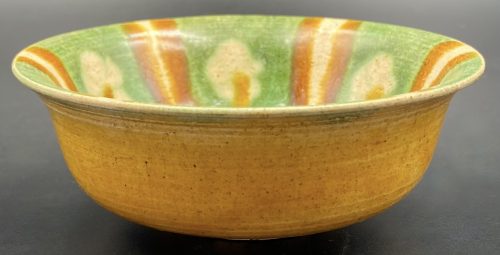 Small stoneware cup with rounded sides raising from a short foot to an inverted rim; glazed inside with a cream and brown six-petal design on a green background with cream and brown stylized flowers. Amber glaze outside, blue bottom, foot unglazed. Dia: 10 cm; H: 4 cm.
Small stoneware cup with rounded sides raising from a short foot to an inverted rim; glazed inside with a cream and brown six-petal design on a green background with cream and brown stylized flowers. Amber glaze outside, blue bottom, foot unglazed. Dia: 10 cm; H: 4 cm. -
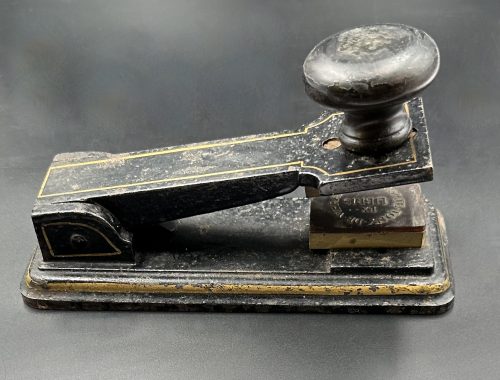 Iron pliers painted black and outlined in gilt lacquer, with wooden handle and bronze seals, "Ex Libris Comte Tony de Vibraye", L17.1 x W6.9 x H7.5 cm. Provenance: Antoine Henri Gaston Hurault de Vibraye [Comte Tony de Vibraye] (French, 1893 – 1951). The book with such a stamp in this library: [LIB-3243.2023] Crébillon fils. La Nuit et le moment ou Les Matinées de Cythère / Illustrations de Sylvain Sauvage. — Paris: Au dépens d’un amateur, 1924.
Iron pliers painted black and outlined in gilt lacquer, with wooden handle and bronze seals, "Ex Libris Comte Tony de Vibraye", L17.1 x W6.9 x H7.5 cm. Provenance: Antoine Henri Gaston Hurault de Vibraye [Comte Tony de Vibraye] (French, 1893 – 1951). The book with such a stamp in this library: [LIB-3243.2023] Crébillon fils. La Nuit et le moment ou Les Matinées de Cythère / Illustrations de Sylvain Sauvage. — Paris: Au dépens d’un amateur, 1924. -
 A yamagane (unrefined copper) ko-kinko tsuba of slightly elongated round form with design of wisteria carved in sculptural relief (nikubori). Copper sekigane. Unsigned. Muromachi period, likely the 16th century.
A yamagane (unrefined copper) ko-kinko tsuba of slightly elongated round form with design of wisteria carved in sculptural relief (nikubori). Copper sekigane. Unsigned. Muromachi period, likely the 16th century.Size: 74.3 x 71.8 x 3.2 mm.
NBTHK certificate №4003986: Hozon (worthy preservation). In custom wooden box. -
 Iron tsuba of oval form with design of stylized paulownia (nage-giri) in openwork (sukashi). Leaf veins carved in kebori technique. Rounded rim. Copper sekigane. Unsigned. Attributed to Kanshirō, third generation Nishigaki (1680-1761). Edo period: Early 18th century (Kyoho / Genbun era). Size: Height: 77.8 mm. Width: 71.9 mm. Rim thickness: 5.9 mm. Center thickness: 5.0 mm. Provenance: Sasano Masayuki Collection, № 264: "Nishigaki. Third generation Kanshiro (died in in the eleventh year of Hohreki, 1761 at the age of eighty-two). This oblong shape appears a little amateurish at first, however, it was done intentionally to add flavor to to the design. The neat composition is a feature of the third Kanshiro."
Iron tsuba of oval form with design of stylized paulownia (nage-giri) in openwork (sukashi). Leaf veins carved in kebori technique. Rounded rim. Copper sekigane. Unsigned. Attributed to Kanshirō, third generation Nishigaki (1680-1761). Edo period: Early 18th century (Kyoho / Genbun era). Size: Height: 77.8 mm. Width: 71.9 mm. Rim thickness: 5.9 mm. Center thickness: 5.0 mm. Provenance: Sasano Masayuki Collection, № 264: "Nishigaki. Third generation Kanshiro (died in in the eleventh year of Hohreki, 1761 at the age of eighty-two). This oblong shape appears a little amateurish at first, however, it was done intentionally to add flavor to to the design. The neat composition is a feature of the third Kanshiro." -
 Mokkō form iron tsuba carved in relief and inlaid with soft metals (copper, gold, silver) with the design of a cormorant fisherman on the face and a boat on the reverse. Unsigned. Dimensions: 77 mm x 69 mm x 3.0 mm (at seppa-dai) Edo period: 18th or 19th century. "Since Nara period, Japanese fishermen in small boats have used cormorants (u) to catch river fish at night, binding the necks of the birds so that the fish are not swallowed. [...] The bird and the work it performs are symbols of selfless devotion to one's master and keen eyesight." - from Merrily Baird. Symbols of Japan. Thematic motifs in art and design. Rizzoli international publications, Inc., 2001; p. 104. See also in this collection TSU-0212 and TSU-0241.
Mokkō form iron tsuba carved in relief and inlaid with soft metals (copper, gold, silver) with the design of a cormorant fisherman on the face and a boat on the reverse. Unsigned. Dimensions: 77 mm x 69 mm x 3.0 mm (at seppa-dai) Edo period: 18th or 19th century. "Since Nara period, Japanese fishermen in small boats have used cormorants (u) to catch river fish at night, binding the necks of the birds so that the fish are not swallowed. [...] The bird and the work it performs are symbols of selfless devotion to one's master and keen eyesight." - from Merrily Baird. Symbols of Japan. Thematic motifs in art and design. Rizzoli international publications, Inc., 2001; p. 104. See also in this collection TSU-0212 and TSU-0241. -
 Iron tsuba of 14-petal chrysanthemoid form (kikka-gata) with alternating solid and openwork petals, the latter outlined with brass wire (sen-zōgan) and the former decorated with brass dots (ten-zōgan), on both sides. Seppa-dai is outlined with brass wire. Small hitsu-ana probably cut later. Late Muromachi period (Ca. 1514-1573). Ōnin school. Unsigned. Dimensions: 87.0 x 87.8 x 3.2 mm. Similar tsuba in this collection: TSU-0420.2022
Iron tsuba of 14-petal chrysanthemoid form (kikka-gata) with alternating solid and openwork petals, the latter outlined with brass wire (sen-zōgan) and the former decorated with brass dots (ten-zōgan), on both sides. Seppa-dai is outlined with brass wire. Small hitsu-ana probably cut later. Late Muromachi period (Ca. 1514-1573). Ōnin school. Unsigned. Dimensions: 87.0 x 87.8 x 3.2 mm. Similar tsuba in this collection: TSU-0420.2022 Other similar specimens can be found at:
Henri L. Joly and Kumasaku Tomita, Japanese art and handicraft, "Swords and sword fittings" section, sub-section “Inlays of Ōnin, Kyoto, Fushimi-Yoshiro, and Kaga Province”, Plate CX, #128: Iron, chrysanthemoid, thin guard with alternate petals covered with brass spots. Ōnin style. 16th century.
Compton Collection, Part I, #7: The iron plate is of flowerhead shape with each of the fourteen petals alternating between solid and openwork. The apertures are outlined in inlaid brass as is the seppa-dai and hitsu-ana. The remainder of the plate is similarly inlaid with plum flowers, birds, dots of dew, Genji mon and sambiki mon. 87 mm x 85 mm x 3.5 mm.
Other similar specimens can be found at:
Henri L. Joly and Kumasaku Tomita, Japanese art and handicraft, "Swords and sword fittings" section, sub-section “Inlays of Ōnin, Kyoto, Fushimi-Yoshiro, and Kaga Province”, Plate CX, #128: Iron, chrysanthemoid, thin guard with alternate petals covered with brass spots. Ōnin style. 16th century.
Compton Collection, Part I, #7: The iron plate is of flowerhead shape with each of the fourteen petals alternating between solid and openwork. The apertures are outlined in inlaid brass as is the seppa-dai and hitsu-ana. The remainder of the plate is similarly inlaid with plum flowers, birds, dots of dew, Genji mon and sambiki mon. 87 mm x 85 mm x 3.5 mm.
Japanese art and handicraft, Plate CX, #128.
And at Jim Gilbert website: Onin ten zogan tsuba, mid Muromachi. Size: 7.7 cm T x 7.6 cm W x 0.3 cm. Iron plate with brass inlay. Kiku gata. The Ōnin ten zogan style is characterized by the decoration of small brass “nail heads” and wires on a thin iron plate. The iron often has a soft, granular texture and seems to be prone to rust. Unfortunately, this rust will undermine the brass inlay and result in the loss of some of the inlay. This example is in reasonably good but far from perfect condition. As is often the case, the backside is better preserved, with the wire around the seppa-dai and kozuka-ana, and all petals still intact.
Compton Collection, Part I, #7.
-

Iron tsuba with hammer marked surface and design of a plum and cherry blossoms to the right of nakaga-ana in openwork (sukashi). Raised rim, typical to katchushi school. The thickness of the plate provides for later Muromachi period making.
Late Muromachi period (1514-1573). Size: 85.8 x 85.0 x 3.6 (center), 4.1 (rim) mm; weight: 136 g. -
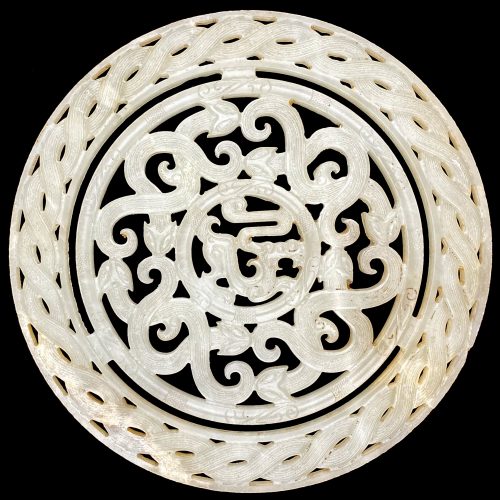 White jade Bi of three concentrical circles: double helix outer, intertwined serpents in the middle and a dragon in centre, carved in openwork and low-relief. China, the Ming Dynasty [大明] (1368 – 1644). Diameter: 15.9 cm; Height: 0.5 cm.
White jade Bi of three concentrical circles: double helix outer, intertwined serpents in the middle and a dragon in centre, carved in openwork and low-relief. China, the Ming Dynasty [大明] (1368 – 1644). Diameter: 15.9 cm; Height: 0.5 cm. -
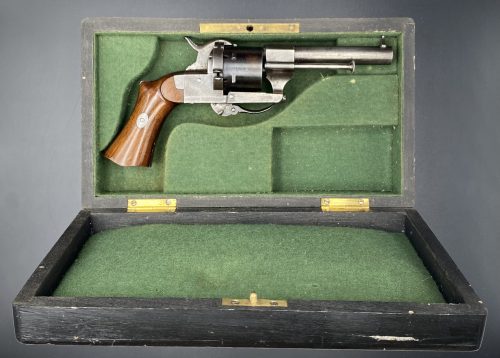
Lefaucheux model 1858 pin-fire self-cocking revolver with ejector rod, folding trigger and polished walnut grips, manufactured in Paris.
Stamped on barrel: E. LEFAUCHEUX BRte S.G.D.G. À PARIS.
Serial number LF 9018; in a wooden case. Dimensions: Case: 23 x 13 x 6 cm; L: 20.5 cm; H: 9 cm; Barrel: 9 cm. Eugene Lefaucheux (French, 1820 – 1871) was the son of Casimir Lefaucheux (French, 1802 – 1852). -
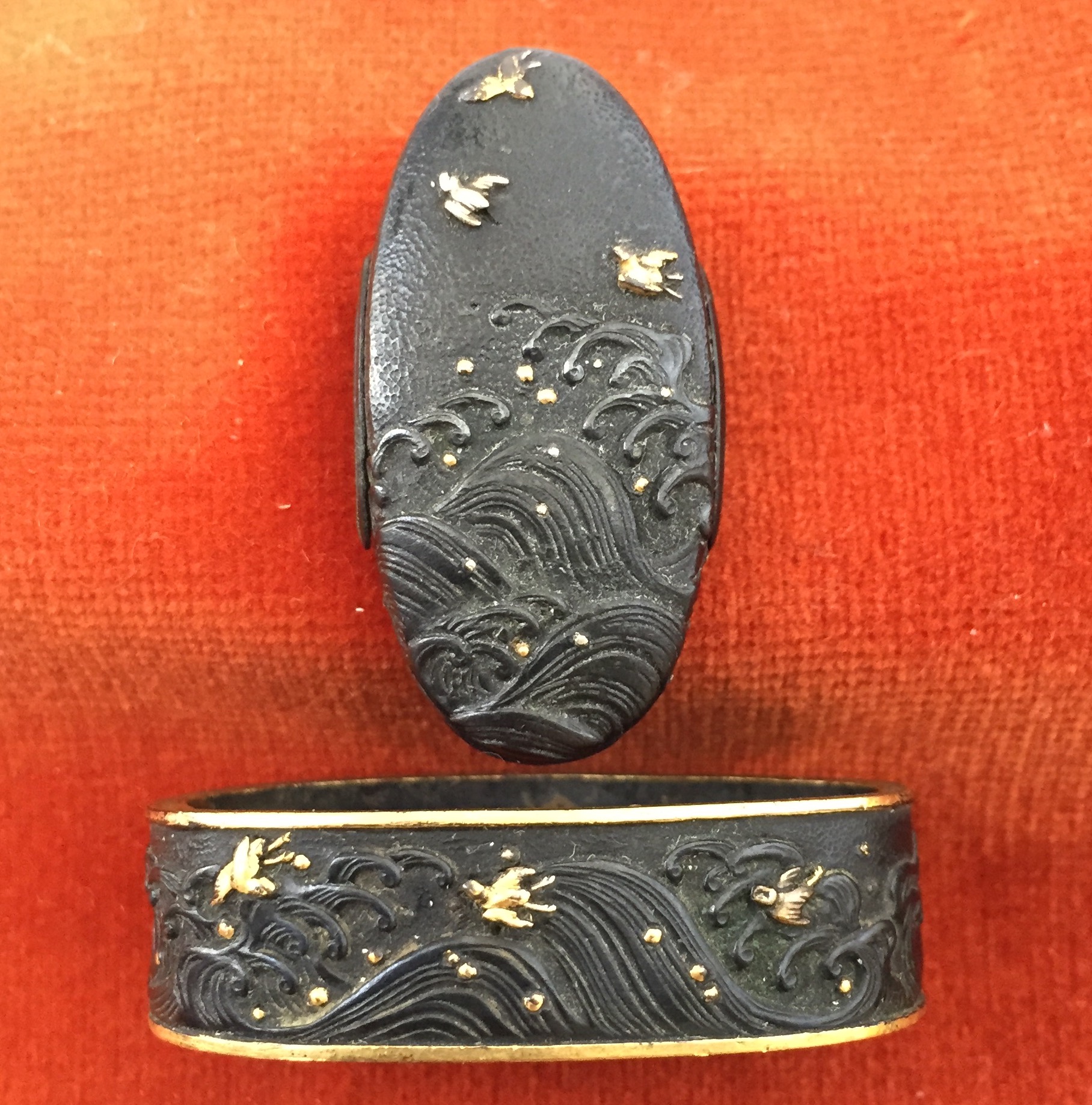 Fuchi: 37 x 21 x 11 mm; Weight: 13 g Kashira: 34 x 16 x 6 mm ; Weight: 10 g Material : Shakudo; Gold. Signature: Unsigned Technique: Sunameji Sukibori Zogan Decoration: Nami Chidori zu (wave & plover)
Fuchi: 37 x 21 x 11 mm; Weight: 13 g Kashira: 34 x 16 x 6 mm ; Weight: 10 g Material : Shakudo; Gold. Signature: Unsigned Technique: Sunameji Sukibori Zogan Decoration: Nami Chidori zu (wave & plover) -
 Iron tsuba of round form with design of slanting rays of light (shakoh) or clock gear (tokei) in openwork (sukashi). Commonly considered a Christian / Jesuit motif. Round-cornered rim. Copper sekigane. Momoyama period: Late 16th century (Tensho/Keicho era). Height: 72.5 mm, Width: 72.2 mm, Rim thickness: 5.5 mm, Center thickness: 5.3 mm. Round-cornered rim. Provenance: Sasano collection. Sasano Masayuki, Japanese Sword Guards Masterpieces from The Sasano Collection, Part I, № 136: "The general belief that this design represents the gear of a clock is erroneous, rather it shows the slanting rays of light from a cross, with the small diamond shapes representing the upright and transverse bars. The Christian influence is obvious..."
Iron tsuba of round form with design of slanting rays of light (shakoh) or clock gear (tokei) in openwork (sukashi). Commonly considered a Christian / Jesuit motif. Round-cornered rim. Copper sekigane. Momoyama period: Late 16th century (Tensho/Keicho era). Height: 72.5 mm, Width: 72.2 mm, Rim thickness: 5.5 mm, Center thickness: 5.3 mm. Round-cornered rim. Provenance: Sasano collection. Sasano Masayuki, Japanese Sword Guards Masterpieces from The Sasano Collection, Part I, № 136: "The general belief that this design represents the gear of a clock is erroneous, rather it shows the slanting rays of light from a cross, with the small diamond shapes representing the upright and transverse bars. The Christian influence is obvious..." -
 Iron tsuba of round form decorated with eight roundels - circular emblems of flowers and/or family crests (mon) made of cast brass, pierced and chiseled in kebori, and with flat brass inlay (hira-zōgan) of vines or seaweed all over the plate. Hitsu-ana outlined in brass. Four positive silhouette roundels are 3-, 4-, 5-, and 6- pointing crests/flowers; four negative silhouette roundels are bellflower, cherry blossom, and suhama. Yoshirō school (Kaga-Yoshirō). The Momoyama or early Edo period, beginning of 17th century. Size: diameter 77 mm, thickness 3,8 mm
Iron tsuba of round form decorated with eight roundels - circular emblems of flowers and/or family crests (mon) made of cast brass, pierced and chiseled in kebori, and with flat brass inlay (hira-zōgan) of vines or seaweed all over the plate. Hitsu-ana outlined in brass. Four positive silhouette roundels are 3-, 4-, 5-, and 6- pointing crests/flowers; four negative silhouette roundels are bellflower, cherry blossom, and suhama. Yoshirō school (Kaga-Yoshirō). The Momoyama or early Edo period, beginning of 17th century. Size: diameter 77 mm, thickness 3,8 mm -
 Iron tsuba of four-lobbed mokkō form decorated in brass and shakudō inlay on the face with design of rotten skull, fly, maple leaf, pine cones and needles, and on the back with design of rotten skull, wild boar, pine cones and needles. Scattered brass dots on both sides. Hitsu-ana possibly cut off later. Surface has traces of lacquer (urushi). Momoyama period. Dimensions: 67.3 x 61.5 x 4.3 mm A similar example can be found at Tsuba Kanshoki by Kazutaro Torogoye, 1975 on p. 61: "Heianjōzōgan tsuba. No sig. Iron: Pine-cone, seeds, ants & rock, brass zōgan. Kakumimi: C. 1.5 bu. Age: Momoyama. Sup. - Early work. Interest."
Iron tsuba of four-lobbed mokkō form decorated in brass and shakudō inlay on the face with design of rotten skull, fly, maple leaf, pine cones and needles, and on the back with design of rotten skull, wild boar, pine cones and needles. Scattered brass dots on both sides. Hitsu-ana possibly cut off later. Surface has traces of lacquer (urushi). Momoyama period. Dimensions: 67.3 x 61.5 x 4.3 mm A similar example can be found at Tsuba Kanshoki by Kazutaro Torogoye, 1975 on p. 61: "Heianjōzōgan tsuba. No sig. Iron: Pine-cone, seeds, ants & rock, brass zōgan. Kakumimi: C. 1.5 bu. Age: Momoyama. Sup. - Early work. Interest."
Tsuba Kanshoki, 1975, p. 61: Heianjō tsuba, Momoyama Period.
-

Iron tsuba of round form pierced (sukashi) and carved (marubori) with a 'noshi' decoration design. Noshi - decoration made of dried abalone (awabi) and bearing an auspicious connotation of good fortune, prosperity, etc. Design was used as a family crest (mon).
Size: 76.3 x 75.9 x 5.5 mm.
Signed: Echizen jū Kinai Saku. Kinai school existed from mid 17th to mid 19th century; it is hard to tell which master (generation from 1 to 6) made this particular piece.
SOLD -

Iron tsuba of square with cut-off edges form (sumi-iri-kakugata) with lattice design in openwork (sukashi) and pierced center.
Unsigned. Late Muromachi period, ca. 16th century.
Size: 73.2 x 72.4 x 3.6 mm References: 1) Tsuba Kanshoki. Kazutaro Torogoye, 1975, p. 95, lower image. It's also called Kyō shōami. 2) KTK-11: Koshi motif, Late Muromachi (16th c.) -
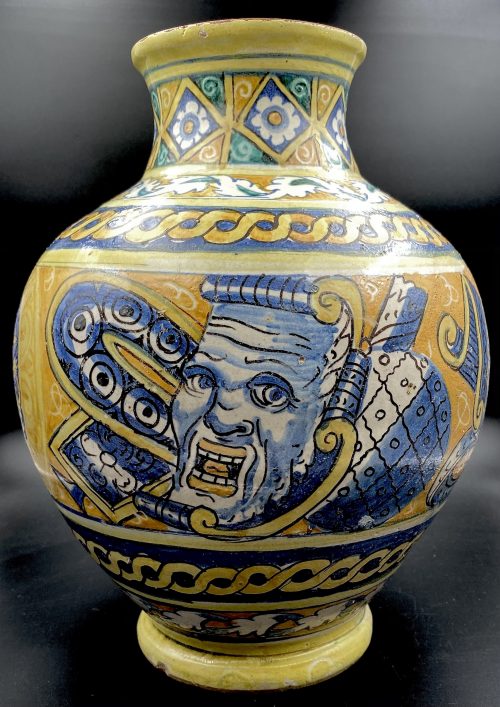
-

Iron tsuba of mokko form decorated with arabesque (karakusa) in low relief carving. niku from 4.0 mm in the centre to 5.1 mm at the rim. Strong Nobuie [信家] signature (futoji-mei) to the left of nakago-ana. Hitsuana plugged with pewter.
Size: H: 88.2 mm, W: 83.6, Th(c): 4.0 mm, Th(r): 5.1 mm Weight: 167 g.Signed: Nobuie [信家]
Probably the work of Nidai Nobuie (c. 1600).
Tokubetsu hozon certificate № 229324 of the N.B.T.H.K., dated 22.12.2010 -
 A ko-tosho tsuba made of iron, of the round form (丸型, maru-gata), pierced in negative silhouette (文透, mon-sukashi) with the design of Shingon Buddhism symbols of vajra [金剛杵] (kongosho), Sun, Moon and Star [月日星] (tsuki-hi-hoshi) – three sources of light [三光] (sankō). Round rim. No hitsu-ana; the shape of nakago-ana may suggest use on naginata [薙刀. Muromachi period (1393 – 1573). Height: 94.4 mm, Width: 93.4 mm, Centre thickness: 3.1 mm. Another possible explanation for "The element at the 11-o’clock position is in my opinion a kemari ball for the courtly game of the same name (picture attached)" [Markus Sesko].
A ko-tosho tsuba made of iron, of the round form (丸型, maru-gata), pierced in negative silhouette (文透, mon-sukashi) with the design of Shingon Buddhism symbols of vajra [金剛杵] (kongosho), Sun, Moon and Star [月日星] (tsuki-hi-hoshi) – three sources of light [三光] (sankō). Round rim. No hitsu-ana; the shape of nakago-ana may suggest use on naginata [薙刀. Muromachi period (1393 – 1573). Height: 94.4 mm, Width: 93.4 mm, Centre thickness: 3.1 mm. Another possible explanation for "The element at the 11-o’clock position is in my opinion a kemari ball for the courtly game of the same name (picture attached)" [Markus Sesko].
Tsukioka Yoshitoshi [月岡 芳年] (Japan, 1839 – 1892): Tokugawa Yoshimune [徳川 吉宗] (1684 – 1751) playing kemari [蹴鞠]
-
 Iron tsuba of round form decorated with eight roundels – circular emblems of flowers and/or family crests (mon) made of cast brass, pierced and chiseled in kebori, and with flat brass inlay (hira-zōgan) of vines or leaves all over the plate. Both hitsu-ana trimmed in brass. Nakago-ana of rectangular form, with copper sekigane. Four positive openwork (ji-sukashi) roundels at 12, 3, 6, and 9 o'clock; and four negative openwork (in-sukashi) roundels with cherry blossom, bellflower, and two variations on suhama theme. Yoshirō school (Kaga-Yoshirō). The Momoyama or early Edo period, late 16th to early 17th century. Size: diameter 81.4 mm, thickness 4.7 mmat seppa-dai, 4.0 mm at rim. Christie's lot description: AN IRON TSUBA; EDO PERIOD (17TH CENTURY). THE DOLPHYN COLLECTION OF SAMURAI ART. The round iron tsuba pierced with roundels of various floral motifs interspersed among scrolling foliage, all inlaid with brass. 8.1 cm. high. Provenance: Pabst Collection (no. 338).
Iron tsuba of round form decorated with eight roundels – circular emblems of flowers and/or family crests (mon) made of cast brass, pierced and chiseled in kebori, and with flat brass inlay (hira-zōgan) of vines or leaves all over the plate. Both hitsu-ana trimmed in brass. Nakago-ana of rectangular form, with copper sekigane. Four positive openwork (ji-sukashi) roundels at 12, 3, 6, and 9 o'clock; and four negative openwork (in-sukashi) roundels with cherry blossom, bellflower, and two variations on suhama theme. Yoshirō school (Kaga-Yoshirō). The Momoyama or early Edo period, late 16th to early 17th century. Size: diameter 81.4 mm, thickness 4.7 mmat seppa-dai, 4.0 mm at rim. Christie's lot description: AN IRON TSUBA; EDO PERIOD (17TH CENTURY). THE DOLPHYN COLLECTION OF SAMURAI ART. The round iron tsuba pierced with roundels of various floral motifs interspersed among scrolling foliage, all inlaid with brass. 8.1 cm. high. Provenance: Pabst Collection (no. 338). -
 Kyo-sukashi iron tsuba of round form with design of hollyhock (aoi ) and wild geese. Slightly rounded rim. Copper sekigane. Momoyama period, late 16th - early 17th century. Height: 82.6 mm, Width: 82.1 mm, Thickness at seppa-dai: 4.5 mm. NTHK (Nihon Token Hozon Kai) certified.
Kyo-sukashi iron tsuba of round form with design of hollyhock (aoi ) and wild geese. Slightly rounded rim. Copper sekigane. Momoyama period, late 16th - early 17th century. Height: 82.6 mm, Width: 82.1 mm, Thickness at seppa-dai: 4.5 mm. NTHK (Nihon Token Hozon Kai) certified. -
 A circular iron tsuba with a design of three monkey toys (kukurizaru) in small openwork (ko-sukashi); the plate further decorated with four rows of brass dot inlay (ten-zogan). The center of the plate and the openings are outlined with brass wire. Copper sekigane. A few dots missing. Muromachi period. Dimensions: 89.0 x 88.2 x 2.9 mm. Kukurizaru was an often used motif on old tsuba. The symbol has two explanations: (1) "upright" monkey, a sort of roly-poly toy, alludes to 'never-ever give up' property of the samurai; (2) monkeys are represented with their hands and feet tied to their back to symbolize self-control. Other examples of the same design:
A circular iron tsuba with a design of three monkey toys (kukurizaru) in small openwork (ko-sukashi); the plate further decorated with four rows of brass dot inlay (ten-zogan). The center of the plate and the openings are outlined with brass wire. Copper sekigane. A few dots missing. Muromachi period. Dimensions: 89.0 x 88.2 x 2.9 mm. Kukurizaru was an often used motif on old tsuba. The symbol has two explanations: (1) "upright" monkey, a sort of roly-poly toy, alludes to 'never-ever give up' property of the samurai; (2) monkeys are represented with their hands and feet tied to their back to symbolize self-control. Other examples of the same design:
The Henry D. Rosin Collection №9.

Lundgren Collection №7.
-

Iron tsuba of circular form with the knotted geese (kari) flying over the rough waves pierced (sukashi) and carved in low relief (nikubori). Hitsu-ana plugged with soft metal. Hitsu-ana plugged with soft metal (tin or lead).
Signed: Echizen koku jū Myochin Katsuharu saku.
Edo period.Size: Height: 80.7 mm; Width: 81.0 mm; Thickness: 4.5 mm; Weight: 110 g.
Two tsuba of this master can be found at Georg Oeder Collection (Japanische Stichblätter und Schwertzieraten. Sammlung Georg Oeder Düsseldorf. Beschreibendes Verzeichnis von P. Vautier. Herausgegeben von Otto Kümmel.Oesterheld & Co / Verlag / Berlin, Oesterheld, 1915; LIB-1465 in this collection) under №№ 172 and 173, page 21, though no illustrations. SOLD. -
 Iron tsuba of round form with design of double crossbar and two family crests (hikiryo-ni-kamon) in openwork (sukashi). Squared rim. Copper sekigane. Owari school. Early Edo period: Late 17th century (Kanbun / Enppo era). Height: 80.9 mm. Width: 80.8 mm. Rim thickness: 5.0 mm. Center thickness: 4.6 mm. Provenance: Sasano Masayuki Collection, № 172: "A paulownia and a clover are diagonally opposite two crossbars. This expressive design suggests a Higo origin, but the iron and the finish are certainly of the Owari school. Work of this nature may have been influenced by Hayashi Matashichi (1613-1699)."
Iron tsuba of round form with design of double crossbar and two family crests (hikiryo-ni-kamon) in openwork (sukashi). Squared rim. Copper sekigane. Owari school. Early Edo period: Late 17th century (Kanbun / Enppo era). Height: 80.9 mm. Width: 80.8 mm. Rim thickness: 5.0 mm. Center thickness: 4.6 mm. Provenance: Sasano Masayuki Collection, № 172: "A paulownia and a clover are diagonally opposite two crossbars. This expressive design suggests a Higo origin, but the iron and the finish are certainly of the Owari school. Work of this nature may have been influenced by Hayashi Matashichi (1613-1699)." -
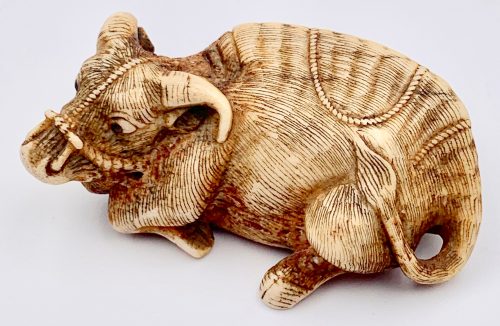 Stag antler netsuke of a recumbent ox. Signed: Tomomasa [友政]. Circa 1800. Dimensions: 56.1 x 20.7 x 36.8 mm Just speculation: There was a master in Kyoto named Tomotada who made netsuke with a recumbent ox motif. Our Tomomasa may be an epigone of a later date. Some even attribute the master to Meiji period. Provenance: Charles Ephrussi (1849-1905) acquired in the 1870s; a wedding gift in 1898 to his cousin Ritter Viktor von Ephrussi (1860-1945) and Baroness Emilie (Emmy) Schey von Koromla (1879-1938); retrieved post-war by their daughter Elizabeth de Waal (1899-1991); given by her to her brother Ignaz (Iggie) Ephrussi (1906-1994), Tokyo; bequeathed by him to his great-nephew Edmund de Waal (born 1964), London, author of “The Hare with Amber Eyes: a hidden inheritance”. London / New York: Chatto & Windus / Farrar, Straus & Giroux. ISBN 978-0099539551. https://en.wikipedia.org/wiki/Charles_Ephrussi. https://en.wikipedia.org/wiki/Ephrussi_family. https://en.wikipedia.org/wiki/Edmund_de_Waal.
Stag antler netsuke of a recumbent ox. Signed: Tomomasa [友政]. Circa 1800. Dimensions: 56.1 x 20.7 x 36.8 mm Just speculation: There was a master in Kyoto named Tomotada who made netsuke with a recumbent ox motif. Our Tomomasa may be an epigone of a later date. Some even attribute the master to Meiji period. Provenance: Charles Ephrussi (1849-1905) acquired in the 1870s; a wedding gift in 1898 to his cousin Ritter Viktor von Ephrussi (1860-1945) and Baroness Emilie (Emmy) Schey von Koromla (1879-1938); retrieved post-war by their daughter Elizabeth de Waal (1899-1991); given by her to her brother Ignaz (Iggie) Ephrussi (1906-1994), Tokyo; bequeathed by him to his great-nephew Edmund de Waal (born 1964), London, author of “The Hare with Amber Eyes: a hidden inheritance”. London / New York: Chatto & Windus / Farrar, Straus & Giroux. ISBN 978-0099539551. https://en.wikipedia.org/wiki/Charles_Ephrussi. https://en.wikipedia.org/wiki/Ephrussi_family. https://en.wikipedia.org/wiki/Edmund_de_Waal. -
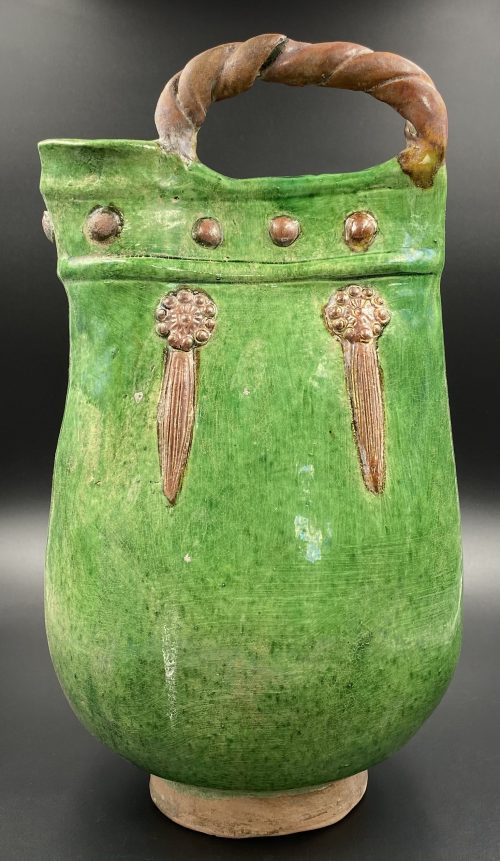 Footed purse-like ewer with twisted handle, with sculptured body glazed in green and details glazed in brown, on an unglazed foot. China, the Liao Dynasty [辽朝] (907 – 1125). Dimensions: 29 x 15 x 15 cm
Footed purse-like ewer with twisted handle, with sculptured body glazed in green and details glazed in brown, on an unglazed foot. China, the Liao Dynasty [辽朝] (907 – 1125). Dimensions: 29 x 15 x 15 cm -
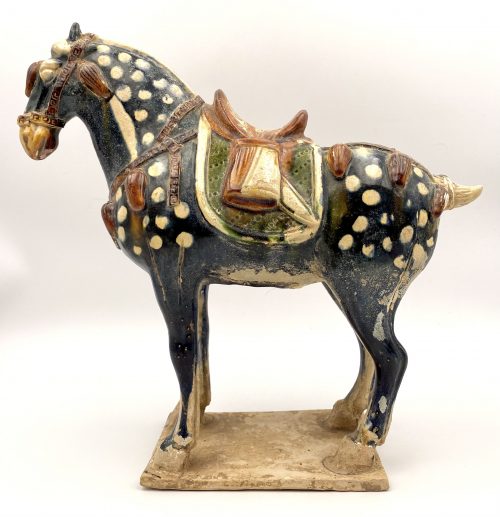 Moulded and sculpted earthenware horse with dark-blue, cream-dappled body, green and cream saddle pad, amber and cream saddle, and amber harness details. H: 28 cm.
Moulded and sculpted earthenware horse with dark-blue, cream-dappled body, green and cream saddle pad, amber and cream saddle, and amber harness details. H: 28 cm.


